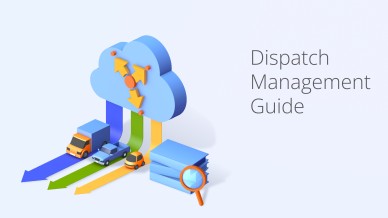Dispatch management isn’t easy.
Whether you are a seasoned logistics professional or new to dispatching, understanding the intricacies of dispatch management is crucial to reducing costs and improving productivity and customer experience.
Dispatch management requires a strategic approach that balances resource optimization, responsiveness, and effective communication.
Therefore, in this blog post, we share the best practices for dispatch management, including the cutting-edge technologies you must use to fine-tune your dispatch process.
Table of Contents
4 Dispatch Management Best Practices
1. Optimize Routes
Planning accurate routes is critical to ensure your team arrives at destinations on time. Plus, by plotting the smartest routes, you can reduce unnecessary minutes spent in traffic for your drivers.
Less travel time means less fuel costs. It’s good for your pocket and the environment, too.
Using pen and paper or spreadsheets, you cannot plan foolproof routes. And Google Maps or Waze is good only if you need to plan routes for up to 10 stops.
You need advanced route planning software like Route4Me to plan well-optimized multi-stop routes for multiple drivers.
It considers weather, traffic congestion, roadblocks, turn restrictions, and more constraints to ensure your drivers never get stuck on the road. And the best part is it takes 30 seconds to plan a route.
So, you save time on route planning, and your drivers save time on traveling.

There are several other ways Route4Me’s dispatch software can help, such as:
- You can plan unlimited routes.
- You can schedule routes for months in advance.
- You can monitor your drivers in real-time and ensure everything goes as planned.
- Route4Me offers a customer alert and notification feature that helps you notify customers about their package status in real time through email, SMS, or voice.
- It offers in-app voice-guided navigation to help your drivers navigate without looking at their mobile.
- Route4Me offers a customer portal feature that helps your end customers track their inbound visits on their own. This reduces the chances of failed appointments.

- It helps assign a balanced workload.
- The route optimizer software allows you to optimize job scheduling depending on the highest priority.
- It enables you to re-optimize routes for any last-minute changes, such as vehicle breakdowns or sudden cancellations of orders.
Want To See For Yourself How Route4Me Can Help with Dispatch Management?

2. Ensure Effective Communication
Miscommunication can lead to errors, delays, and potential safety hazards. Therefore, you must establish clear communication with your team.
Clear communication ensures that all involved parties are on the same page, facilitating effective coordination. This is particularly important in emergency situations where seamless collaboration is critical.
So, how can you better communicate with your field team? Here are some ideas.
- Avoid giving complex instructions to leave no room for misinterpretation. Use clear and concise language.
- Leverage communication apps or messaging platforms designed for logistics. It should be easy to learn and use to ensure quick and seamless communication.
- Create standardized procedures for communication, including specific protocols for order updates, delays, or changes.
- Inform drivers about any unexpected developments or changes, such as route modifications or last-minute cancellations, in real time to enable your drivers to adapt quickly.
- Regularly review communication processes and ask for driver feedback to identify improvement areas.
3. Assess Your Team’s Capability
To ensure efficient scheduling, you must comprehensively understand your field service or driver’s skills and responsibilities at a granular level. Below are some ways you can do it.
- Identify the factors that affect your field service rep or driver’s ability to perform at their best.
- Find out whether your team has the necessary tools and resources they need while on the field.
- Determine the information your team needs before addressing a service call.
- Assess the availability of your field service reps in a particular area to handle impromptu service calls or if you need to dedicate a time slot every day for such unforeseen requests.
4. Collect Data and Analyze
You cannot improve dispatching unless you know what to improve. And that’s why you need to collect data about your delivery operations.
Data such as mileage accumulated by each vehicle and average time spent reaching each destination can help you improve the efficiency of your field service operation.
Data also helps you assess how well your team or business performs compared to your competitors to stay ahead.
Manually collecting and analyzing such data is tedious and time-consuming. But dispatch software can help.
Multi-Stop Route Planner App

An advanced dispatch software like Route4Me offers a reporting and analytics feature that helps you track all the critical parameters needed to improve performance and reduce costs, such as:
- Distance (Planned vs Actual)
- Stops (Visited vs Non-visited)
- Stops (Planned vs Visited)
- Average gas cost
- Total gas cost and more.
The software offers a Dashboard that helps you visualize all such data in a single centrally-synced control panel.
 Frequently Asked Questions(FAQs) about Dispatch Management Best Practices
Frequently Asked Questions(FAQs) about Dispatch Management Best Practices
What is a dispatch process?
What is a dispatch management system?
Final Thoughts about Dispatch Management Best Practices
Effective dispatch and route management software makes your field service operation seamless and profitable. Adopting best practices such as route optimization and effective communication can improve efficiency and boost customer satisfaction.
Moreover, using modern dispatch management solutions, you can manage challenges seamlessly and stay ahead of your competitors.
Want To See For Yourself How Route4Me Can Help with Dispatch Management?








